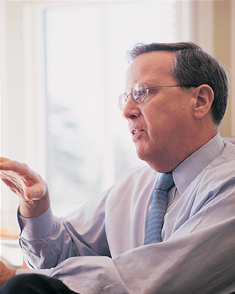 loading
loading
Q&A: Rick LevinThe state of Yale’s endowmentAn interview with Yale president Richard Levin ’74PhD  Mark OstowView full imageY: The Yale endowment saw almost a 25 percent loss in the last fiscal year, which ended June 30. Some people were surprised, since only a small percentage of the endowment is in U.S. stocks. What factors caused the decline? L: Actually we experienced a total loss of 29 percent; we lost almost 25 percent on our existing investments, added nearly 1 percent in new gifts, and spent 5 percent to support our operations. It’s not surprising that we would see a negative investment return in our total endowment despite having only a small share in the U.S. stock market. For example, we have about a quarter of the endowment invested in private equities. Most of our managers in this sector make their profits by purchasing companies, taking them private, and then selling them years later in public offerings. A down market limits their opportunities to sell companies at a profit, and the accounting rules require that we mark these investments down to the value at which they would sell today. We also had nearly a third of the endowment in real assets, such as timber and real estate, and that category saw significant losses as the economy slowed. Y: Yale has by now cut this year’s budget nearly 10 percent from the previous year. Is that because so much of the operating budget, more than 40 percent, is funded by endowment returns? L: Yes. A $6.5 billion decrease in our endowment creates a deficit of about $350 million per year in our operating budget. We made cuts of approximately $200 million in this year’s budget, and we will have to cut about $150 million more in the budget we are now preparing for next year. Y: After all these cuts, and layoffs of more than 100 people, are you still satisfied with the strategy of keeping 96 percent of the endowment in investments that produce high returns but carry risk? L: We’ve had one bad year, but in four of the five previous years, we had gains in excess of 19 percent. We are dramatically better off now than we would have been if we had pursued a traditional strategy of 60 percent bonds, 40 percent stocks. And, going forward, as markets begin to recover, we believe that our strategy will serve the university well. Y: In 2007 and 2008, Congress was putting pressure on universities with large endowments to spend more of their returns, and several, including Yale, increased spending on financial aid. One could argue that this dramatic decline shows that the university should have spent more conservatively. L: It is true that we responded to Congressional pressure in 2008 by raising our spending rate to 5.0 percent. But, historically, our spending policy has been conservative. It is designed to produce a spending stream that fluctuates less than the endowment itself. Spending is low following rapid growth in the endowment, and high following a rapid decline. In the decade prior to the crisis, as the endowment grew rapidly, spending was consistently below 4.5 percent and as low as 3.7 percent in 2006 and 2007. By contrast, this year’s spending is nearly 7 percent; next year’s is forecast to be 6.3 percent. As the endowment recovers, we will gradually work back toward our target rate of 5.25 percent. Y: For many people on campus, it’s hard to understand why Yale needs to lay off employees when it still has a $16 billion endowment. L: Our spending policy is designed to preserve the value of the endowment over the long haul. If we persistently overspend, we run the risk of diminishing the value of our donors’ gifts. We did persistently overspend in the years that the endowment performed poorly from 1968 through 1982, and the endowment lost 50 percent of its purchasing power. We do not wish to repeat that experience. Y: David Swensen [’80PhD, Yale’s chief investment officer] has shared his investment strategies with many other colleges and universities. After the market crash, the Chronicle of Higher Education and others said smaller institutions suffered because they followed his lead. L: Two observations. One is, David’s ideas about endowment management won acceptance because they are good ideas. Before his book [Pioneering Portfolio Management] came out, many institutions had already started to adopt his ideas. Second, David, in his published writings and talks, makes it very clear that the success of Yale’s strategy depends in part on scale. Very small endowments can’t get access to the kinds of private investment opportunities that Yale and our peer institutions have. Many of our managers are looking for minimum investments in the range of $50 million to $100 million. David also has made clear his reservations about the kinds of investments that smaller endowments should avoid. Many institutions failed to heed his advice, investing instead in so-called “funds of funds,” which have management fees piled on top of management fees. Y: What’s the prognosis for the endowment in this fiscal year? Around campus I’ve heard guesses of another loss of more than 10 percent. L: At the beginning of the current academic year, we were predicting that the endowment would remain flat through June 30, 2010. But so far this fiscal year, we are seeing a small gain, as the market has started to recover.
The comment period has expired.
|
|